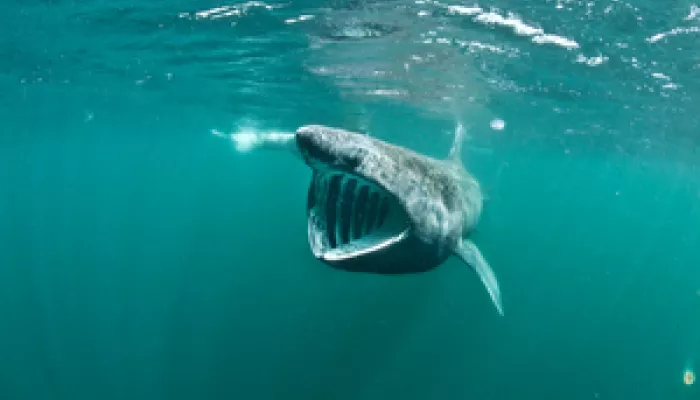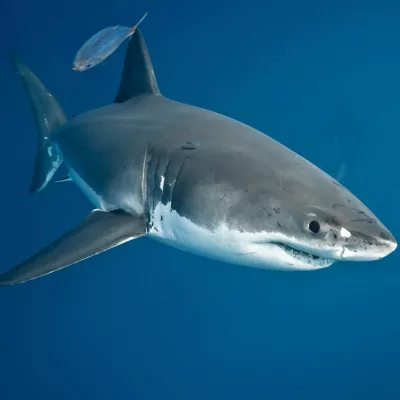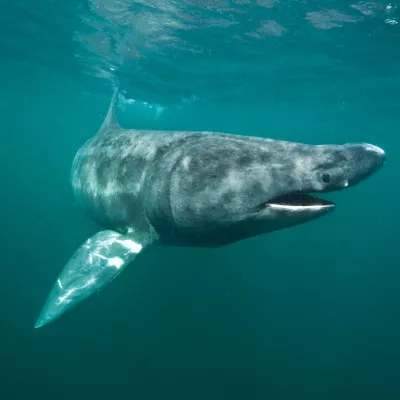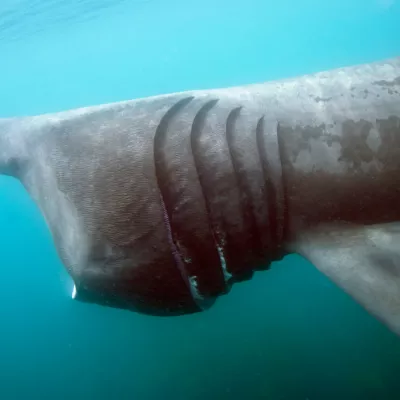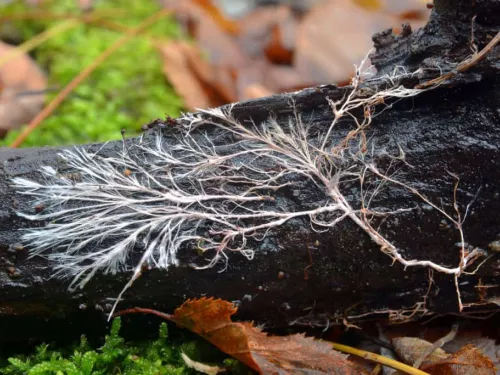A research project conducted by scientists at Queen’s University in Belfast and the University of Roehampton recorded several basking sharks leaping, almost vertically, from the sea, reaching heights of up to 1.2m above the surface of the water. In order to achieve this athletic feat, they noted that the sharks increased the speed of their tail beat motion by six times and achieved swimming speeds of 5.1metres per second.
But while great whites are often seen breaching in pursuit of prey, like seals or otters, we don’t know why basking sharks do this.
Some scientists believe that breaching may support the hunting process - giving a feeding basking shark a one up on other nearby sharks - or that it may help them to remove parasites. Others have speculated that the behaviour may be a form of social interaction or courtship ritual – with males jumping to display strength and virility and females to demonstrate their readiness to mate. For now, at least, the mystery of the basking shark breach continues…
Dating in the deep
There’s a lot that scientists still don’t know about the reproductive behaviours of basking sharks, or any sharks for that matter. Unlike many other creatures, very few sharks have been observed mating, which, given the fact that it happens in the vast expanses of the ocean and at potentially great depths, perhaps isn’t all that surprising.
Basking sharks, who are thought to live up to 50 years, are believed to reach sexual maturity at between 12-16 years (males) and at around 20 years (females), but little is known about how these slow and often solo creatures find a mate. Scientists have, though, observed some unexpected and intriguing behaviour.
For most of us the idea of sharks circling probably conjures up a rather ominous image, and for many years, researchers were puzzled by rare sightings of basking sharks doing just this. But a recent study by the Marine Biological Association, the Irish Basking Group and other researchers, which used drones and underwater cameras to observe 19 groups of sharks off the coast of County Clare, Ireland, has suggested that there might be an altogether more… romantic explanation. Scientists believe that these rings of sharks - known as a ‘torus’ - might in fact be a sort of courtship or mate-selection ritual: a behaviour they have termed shark speed dating!
Amongst all the mystery surrounding their reproductive habits, one thing is clear: basking shark mothers are willing to put in the time – at least during pregnancy.
Like a number of other shark species, these giant fish are viviparous, which means that they give birth to live young. The female produces eggs but, whereas other species such as cat sharks and bamboo sharks lay their eggs (producing the ‘mermaid purse’ egg cases that often wash up on our beaches), a basking shark’s eggs will actually hatch inside the mother’s uterus.
After a mammoth pregnancy - it is widely believed that the gesticulation period for an expectant mother can last up to three years! - the newly born pups will already measure between 1.5 and two metres in length. Once born - as is common with sharks - it is believed that they will separate almost immediately from the mother, swimming off to begin their lives alone.
And while whale sharks give birth to large numbers of offspring (one individual was found to be carrying over 300 pups!), basking shark offspring are much fewer in number, with scientists believing that up to 6 basking babies are the norm. This is just one factor which is impacting upon basking shark populations.
The basking shark’s biggest predator: humans
Globally, basking sharks are in decline. The Save our Wild Isles campaign (RSPB, WWF, and National Trust) estimates that around 80% have been lost in the last decade. And they are categorised as endangered by the International Union for Conservation of Nature (IUCN).
This is hardly surprising, given that these fascinating creatures have faced many challenges in their history. With their slow movement and low rates of reproduction, their populations have been particularly vulnerable to human impact. Basking sharks, like many others, have been heavily hunted for centuries for their oil-rich livers, which make up 25% of their body weight, as well as for their skin, meat, and fins. Shark liver oil was historically used to fuel lamps and latterly in a whole host of products, including industrial lubricants, perfumes, and cosmetics.
It seems incredible that the last remaining basking shark fishery in the UK only closed in 1995 – less than 30 years ago. Thankfully, the UK government officially outlawed the fishing of basking sharks in UK waters in 1998, with the EU following suit in 2007. But while they are now afforded heavy environmental protection by many countries, they still face considerable risks from:
The marine industry
- Because they feed closer to the surface of the water, basking sharks are particularly vulnerable to being struck by ships and getting tangled or caught in fishing lines and nets. Sources such as the Natural History Museum suggest that such incidences remain relatively common in UK waters.
- Sadly, they are still hunted in parts of the world where shark fin soup is considered a delicacy. With their large fins, basking sharks and whale sharks are particularly prized by hunters, making these gentle giants especially vulnerable.
Nature and climate crises
- In 2023, research by the 5 Gyres Institute estimated that around 171 trillion pieces of plastic - both larger pieces, like water bottles, as well as microplastics (particles of 5mm or smaller) - are now lurking menacingly in our oceans. Basking sharks are thought to be especially susceptible to ingesting microplastics, both from their consumption of zooplankton - which contain these harmful particles - and from the microplastics contained within the huge quantities of water that they take in each hour. Designed to filter out and trap microscopic food particles, it is believed that a basking shark’s gill rakers are sadly likely to be just as adept at trapping microplastics as they are zooplankton. A 2014 study estimated that basking sharks are likely to consume up to 13,100 pieces of micro debris each day.
- While we can’t predict exactly how the climate crisis will impact basking sharks, scientists believe that global temperature rises, warmer seas, and changing currents are likely to impact plankton populations and their distribution – reducing the available food sources of basking sharks and altering their migration patterns. It is possible that such changes may lead basking sharks to travel elsewhere in search of food, which would be a devastating loss for UK waters.

